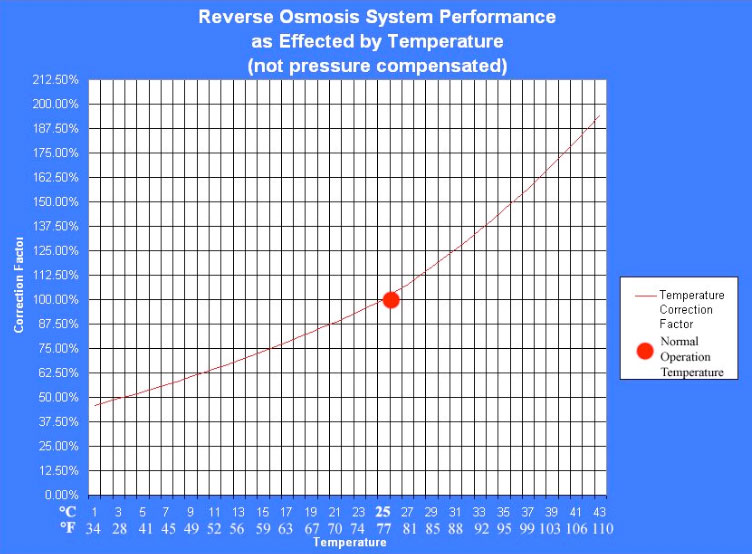WaterProfessionals® have water treatment staff to assist you in evaluating appropriate technologies to achieve your goals in water treatment, or water reclaim and reuse. This usually begins with a thorough water analysis, an understanding of the final water quality required and operating parameters (e.g., flow, temperature, pressure, discharge limitations, etc).
In addition, we need to know your preferences for specifying PLC’s, valves, monitors and controllers. Application of proper treatment technologies requires in-depth understanding of how each works and its limitations. This is our expertise. Some considerations involving reverse osmosis are discussed below.
Raw Water Temperature and Reverse Osmosis
The density of water changes with temperature; its maximum density is reached in the form of ice at 32° F and its density decreases almost linearly as its temperature increases. Since reverse osmosis involves the passage of water molecules through a semi-permeable membrane, the “thicker” or denser the water, the slower the passage
In reverse osmosis applications, most feedwater temperature fluctuates based on ambient temperature, often ranging from 40° F to 70° F if sourced from lakes, rivers or streams. Well water in much of the world maintains stable year-around temperatures of ~ 55° F. In arid or tropical areas, the temperature of well and surface waters will be significantly higher.
Confusion and potential misapplication of RO equipment ensues because many years ago, manufacturers of RO membranes selected 77° F as the standard or “normalized” temperature at which to rate the flow capacity of their membranes. However, very few real-world applications use a feedwater which is consistently at 77° F. For example, technical specifications from most RO manufacturers list a 100 gallons per minute (gpm) RO with small print at the bottom of the page indicating this is at 77° F. However, if the raw water fluctuates as described above, the “100 gpm” RO output will be approximately 52 gpm at 40° F and 88 gpm at 70° F. Obviously if the system is selected based on output at 77° F, there will be a deficit, equal to 50% during some months of the year. While your vendor should point this out, not all may be aware, or they may fear that sizing the machine correctly for the lowest possible feedwater temperature will make them uncompetitive since it requires a larger machine with more membranes.
In the above example, the machine must be sized for the lowest temperature, requiring one rated for ~190 gpm at 77° F in order to produce 100 gpm at the low temperature of 40° F. When the feedwater reaches 70° F, this machine will be producing about 165 gpm. This presents the following critical considerations:
- The RO product water storage tank should have enough capacity so that the RO system does not have to be turned off and on, due to a full tank, more often than every ~30 mins when operating at the peak feedwater temperature.
- Piping plans and sewer capacity must be capable of handling a reject stream ranging from 33 gpm to 55 gpm.
- Pretreatment equipment (e.g., softener, depth filter, iron filter, carbon filter) must be capable of treating the range of feedwater demanded by the RO, ranging from 133 gpm to 220 gpm.
- Incoming raw water supply must be capable of supporting a flow of 133 to 220 gpm at the minimum dynamic pressure required (typically 35 psi).
- Integration of a variable frequency drive RO pump in the initial plan can help modulate the flow since pump output is adjustable.
Temperature is one of several very important considerations involving RO equipment and ancillary equipment plans. The following chart provides temperature correction factors for a wide range of feedwater temperatures.


